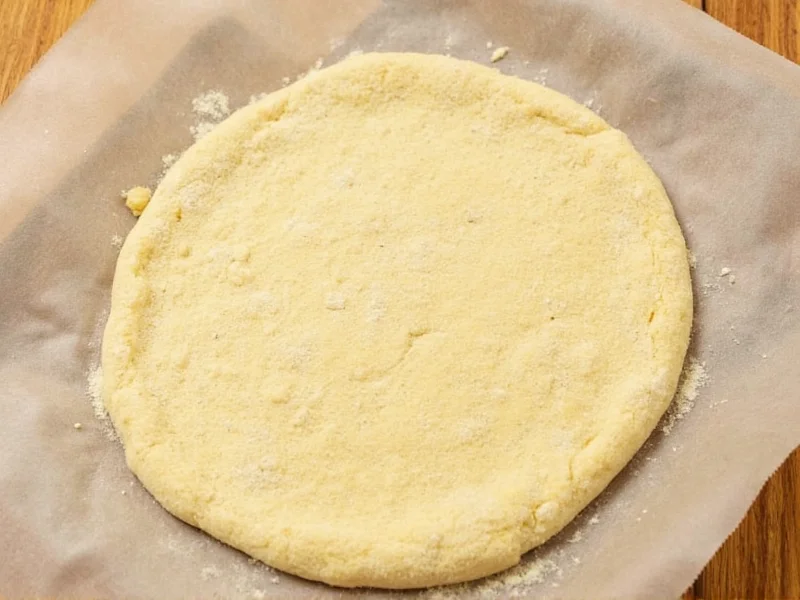When crafting authentic pizza at home, few ingredients transform the experience like properly applied cornmeal. This humble pantry staple serves multiple critical functions in pizza making that extend far beyond simple non-stick properties. Understanding the science and technique behind using cornmeal for pizza crust can elevate your homemade pies from good to exceptional.
The Science Behind Cornmeal's Pizza Magic
Cornmeal's effectiveness stems from its unique physical properties. Unlike wheat flour which absorbs moisture and becomes sticky when exposed to dough, cornmeal particles remain relatively dry due to their lower gluten content and different starch structure. When sprinkled on a pizza peel or stone, these coarse particles create thousands of microscopic contact points that minimize surface area between the dough and cooking surface.
As your pizza bakes, the cornmeal undergoes two beneficial transformations: it toasts slightly, developing a pleasant nutty aroma that transfers to the crust, and it dehydrates further, creating an ultra-crisp interface layer. This explains why cornmeal makes pizza crust crispy along the bottom edge - a desirable textural contrast to the chewy interior.
Choosing the Right Cornmeal for Pizza
Not all cornmeal performs equally well for pizza making. The grind size significantly impacts both functionality and final texture:
| Cornmeal Type | Grind Size (mm) | Best For | Texture Result |
|---|---|---|---|
| Stone-ground coarse | 0.8-1.2 | Wood-fired ovens, high-temp baking | Pronounced crunch, rustic appearance |
| Medium grind | 0.5-0.8 | Home ovens, standard pizza stones | Balanced crispness without excessive crunch |
| Fine cornmeal | 0.3-0.5 | Thin crust styles, minimal texture change | Subtle crispness, nearly seamless integration |
| Semolina flour | 0.2-0.4 | Traditional Neapolitan style | Delicate crunch, golden color |
For most home pizza makers, medium-grind cornmeal provides the ideal balance. It offers sufficient non-stick properties without creating an overly crunchy or gritty texture. Stone-ground varieties contain more of the corn's germ and bran, contributing additional flavor complexity that complements artisanal pizza styles.
Proper Technique: How to Use Cornmeal for Pizza
The technique matters as much as the cornmeal selection. Follow these steps for flawless pizza transfers:
- Prepare your surface: Lightly dust your pizza peel with cornmeal, focusing on the center where the dough will rest. Use approximately 1-2 tablespoons for a 12-inch pizza.
- Shake test: Before adding dough, gently shake the peel. The cornmeal should move freely but not blow away. Add more if needed, but avoid thick layers.
- Shape dough off- peel: Stretch your dough on a clean counter, then carefully transfer it to the prepared peel.
- Final dusting: Sprinkle a light additional layer of cornmeal over the dough's bottom surface before adding toppings.
- Transfer technique: Use quick, confident back-and-forth motions to slide the pizza onto your stone or steel.
Avoid the common mistake of using too much cornmeal for pizza crust - excess cornmeal will burn in the oven, creating bitter spots and potentially smoking your kitchen. The ideal amount creates a visible but thin layer that completely covers the peel surface without piling up.
Cornmeal vs. Alternatives: Making the Right Choice
While cornmeal remains the traditional choice, several alternatives work well depending on your desired outcome:
- Semolina flour: Offers similar non-stick properties with finer texture and milder flavor. Many pizzerias prefer semolina for its cleaner appearance and slightly higher smoke point.
- Rice flour: Creates exceptional crispness with neutral flavor, ideal for gluten-free pizza crusts.
- Regular wheat flour: Provides minimal non-stick benefit and can create gumminess when exposed to moisture.
For authentic New York-style pizza, medium-grind yellow cornmeal delivers that characteristic rustic crunch along the crust's edge. If you're wondering why use cornmeal on pizza peel specifically, it's because the coarse texture maintains its integrity at high temperatures where finer flours would burn or absorb too much moisture.
Troubleshooting Common Cornmeal Issues
Even experienced pizza makers encounter challenges with cornmeal. Here's how to solve frequent problems:
Pizza sticks despite cornmeal: You likely used insufficient cornmeal or let the shaped pizza sit too long before baking. Dough moisture seeps through and activates the cornmeal's limited starches. Work quickly after transferring dough to the peel.
Burnt cornmeal spots: This indicates either too much cornmeal or oven temperature exceeding the cornmeal's smoke point (around 400°F/204°C for extended periods). Reduce quantity or lower oven temperature slightly.
Excessive crunch: If the bottom crust is unpleasantly crunchy, switch to a finer grind or reduce the amount. For delicate thin-crust styles, consider semolina instead of traditional cornmeal.
Advanced Applications and Recipes
For those wanting to incorporate cornmeal directly into their dough, try this simple modification to standard pizza dough recipes:
Replace 10-15% of your regular flour with fine cornmeal (about 20-30g per 200g flour). This creates a subtly textured crust with enhanced crispness that maintains excellent chew. Note that cornmeal contains no gluten, so exceeding 15% replacement will weaken the dough structure.
When experimenting with cornmeal pizza crust recipes, remember that different corn varieties produce distinct flavor profiles. White cornmeal offers a milder taste preferred for delicate toppings, while yellow cornmeal provides more pronounced corn flavor that complements robust ingredients like sausage and peppers.











 浙公网安备
33010002000092号
浙公网安备
33010002000092号 浙B2-20120091-4
浙B2-20120091-4